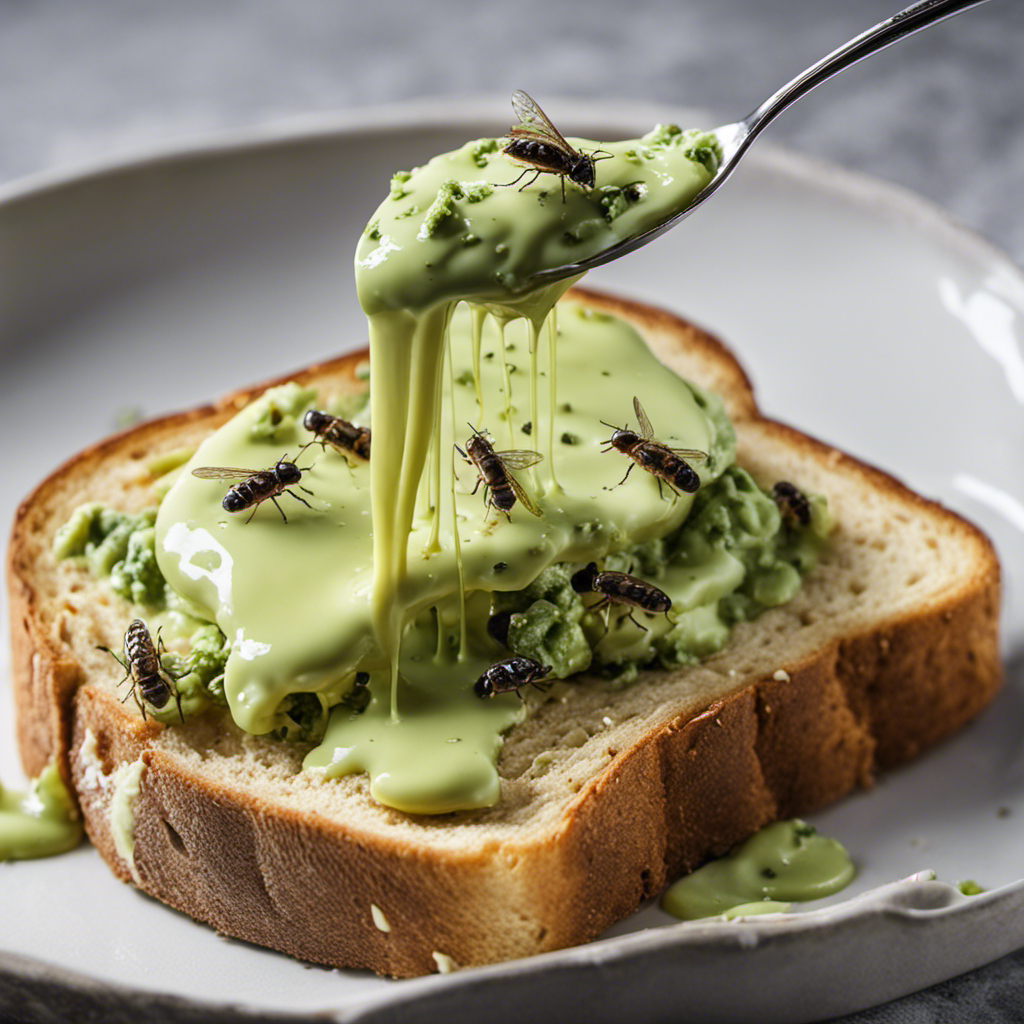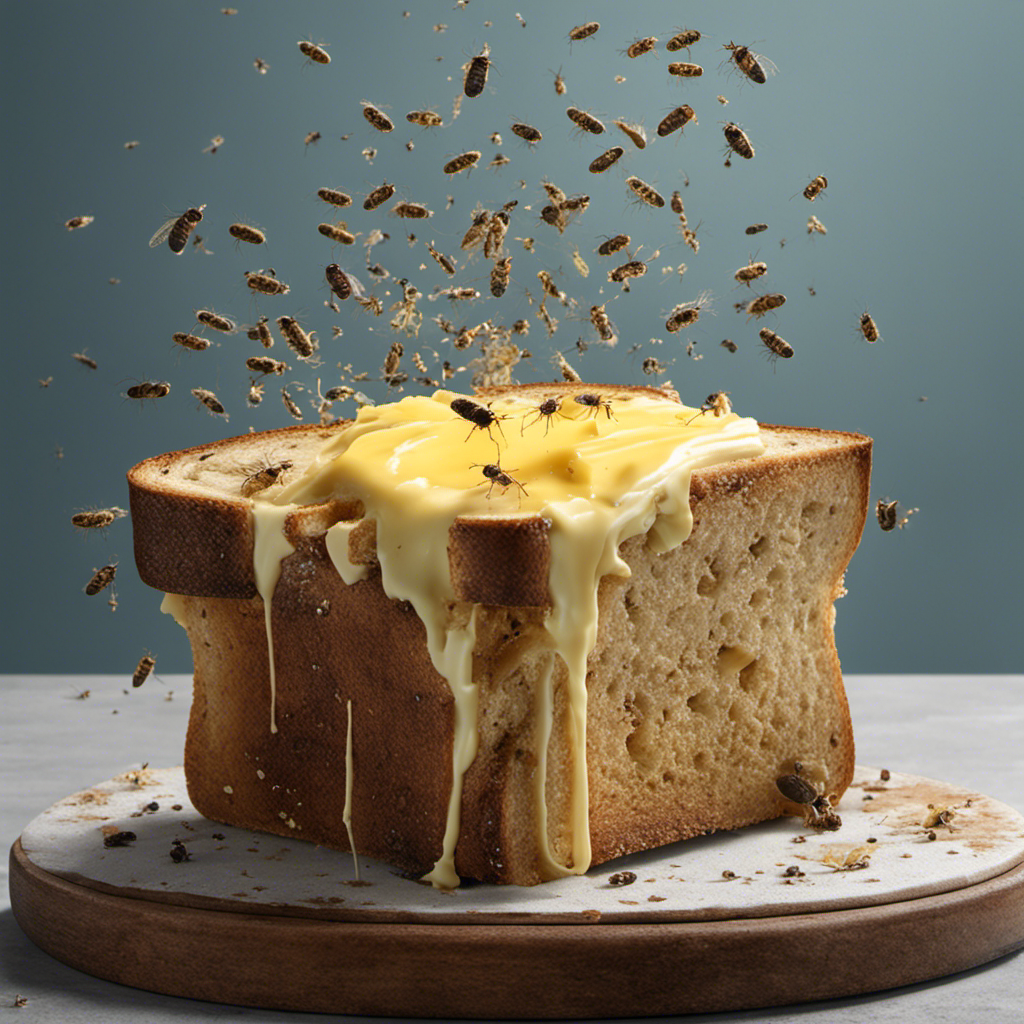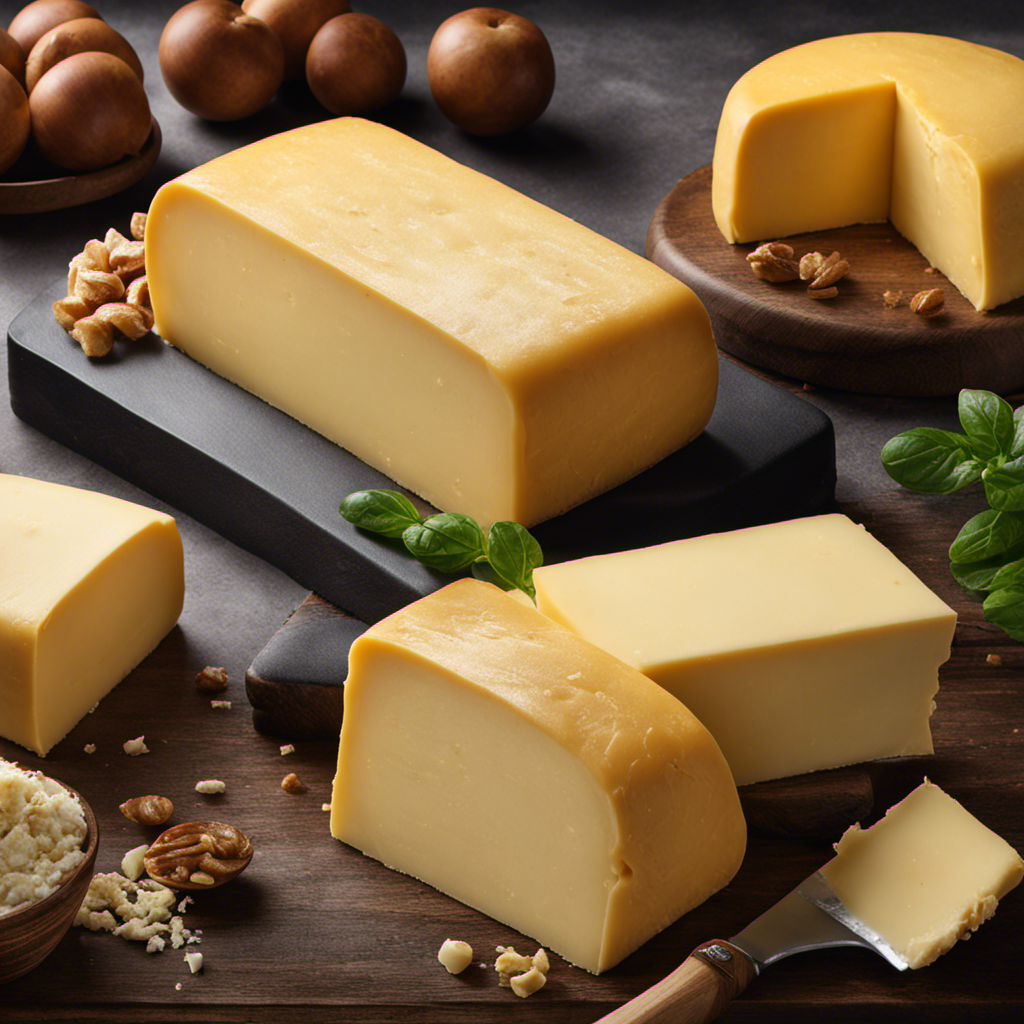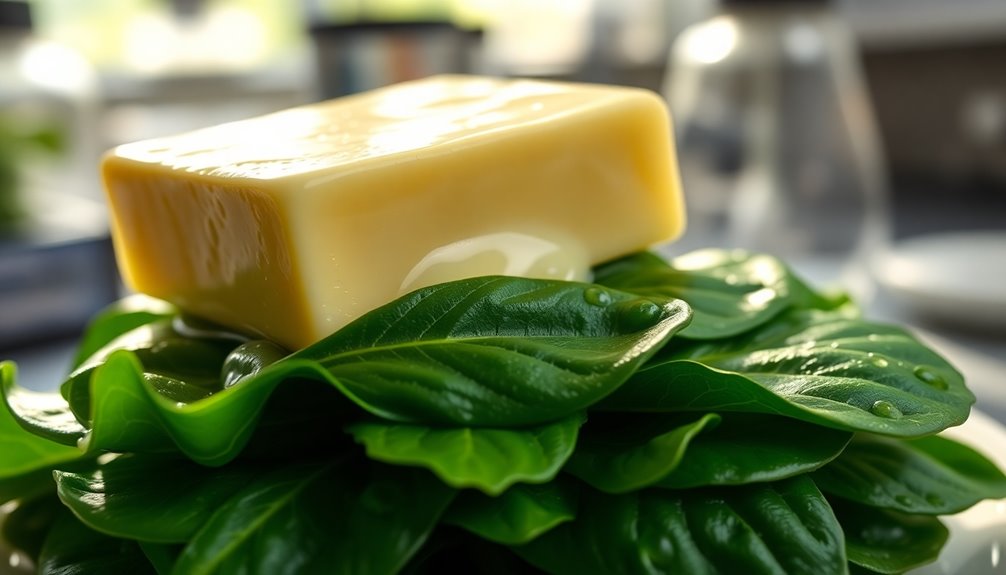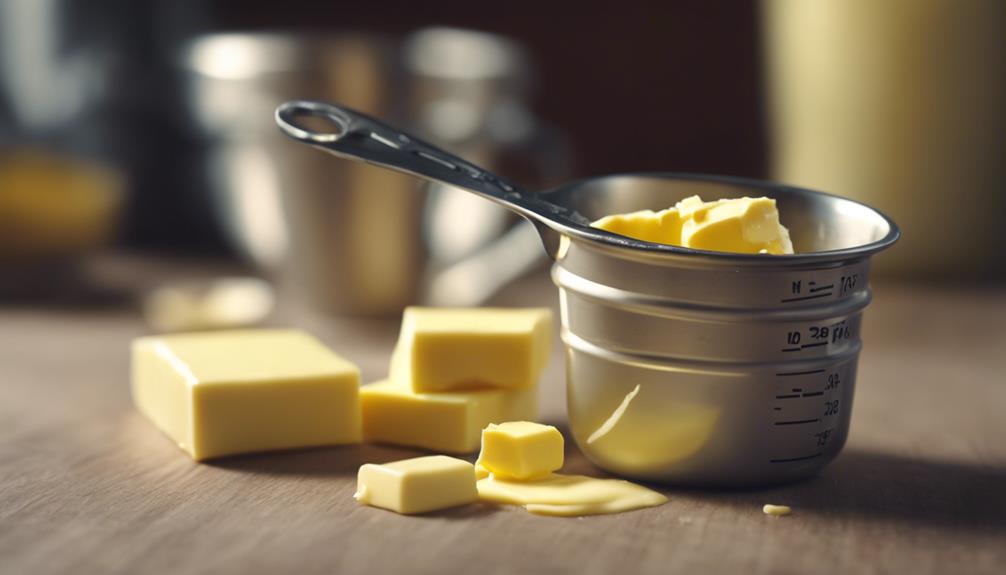Have you ever considered the consequences of eating rancid butter? Let’s explore the potential results of this behavior together.
Spoiled butter can lead to various health risks, causing digestive issues and potentially even bacterial contamination. Not only that, but rancid butter can also have a significant impact on its taste and smell. For those with allergies, consuming spoiled butter can trigger allergic reactions.
To avoid these problems, proper storage and handling of butter are crucial. Let’s delve deeper into the details and arm ourselves with knowledge to make informed choices about our food.
Key Takeaways
- Consuming spoiled butter can lead to unpleasant taste and smell due to rancidity.
- Mold growth on bad butter can be harmful and may cause foodborne illnesses.
- Eating spoiled butter can result in digestive issues such as diarrhea and nausea.
- Proper storage and handling of butter can minimize the risk of bacterial contamination.
Signs of Spoiled Butter
If you eat bad butter, you may experience stomach cramps and diarrhea. It is important to be aware of the signs of spoiled butter to avoid any potential health risks.
One of the key indicators is the shelf life of the butter. Butter typically has a shelf life of about one to two weeks when stored in the refrigerator. If the butter has exceeded this timeframe, it may have gone bad. Other signs of spoiled butter include a rancid or sour smell, mold growth, and an off-color appearance.
If you have expired butter that you don’t want to waste, there are a few ways to use it up. You can incorporate it into baking recipes or use it for sautéing vegetables to add flavor. Just be sure to carefully check the butter for any signs of spoilage before using it.
Health Risks of Consuming Bad Butter
Be aware that consuming spoiled butter can pose health risks to you. It is important to recognize the signs of butter spoilage and practice proper butter storage to prevent any potential harm. Here are three key factors to consider:
-
Rancidity: Spoiled butter often develops a rancid smell and taste due to the breakdown of fats. The presence of a sour or unpleasant odor is a clear indication of spoilage.
-
Mold growth: Mold can thrive on butter if it is not stored properly. Visible mold growth, characterized by fuzzy or discolored patches, indicates that the butter is no longer safe to consume.
-
Bacterial contamination: Spoiled butter may contain harmful bacteria such as Salmonella or Listeria. These pathogens can lead to foodborne illnesses, causing symptoms like diarrhea, nausea, and vomiting.
To ensure food safety, store butter in a cool, dry place away from direct sunlight. Use a covered butter dish or an airtight container to protect it from external contaminants. Regularly check for signs of spoilage and discard any butter that shows these indicators to safeguard your health.
Digestive Issues Caused by Eating Spoiled Butter
Eating spoiled butter can cause digestive issues, such as diarrhea and nausea. When butter goes bad, it can become contaminated with harmful bacteria like Salmonella or Listeria. These bacteria can multiply and produce toxins, leading to foodborne illness.
Digestive discomfort is a common symptom of consuming spoiled butter due to the presence of these pathogens. Diarrhea occurs as a result of the body’s defense mechanism to eliminate the harmful substances. Nausea, on the other hand, is the feeling of sickness in the stomach that often precedes vomiting.
These symptoms can range from mild to severe, depending on the level of contamination and individual susceptibility. It is crucial to properly store and handle butter to prevent the growth of bacteria and reduce the risk of experiencing these unpleasant digestive issues.
Potential Bacterial Contamination in Bad Butter
To avoid potential bacterial contamination, it is important to properly store and handle butter. Bacterial growth in butter can pose health risks. Here are three important tips to prevent bacterial contamination:
-
Store butter in the refrigerator: Keeping butter at a temperature below 40°F (4°C) inhibits the growth of bacteria. It is crucial to promptly return butter to the refrigerator after use to maintain its quality and safety.
-
Use clean utensils: When scooping butter from the container, always use clean and dry utensils. Avoid using wet or dirty utensils, as they can introduce harmful bacteria into the butter.
-
Avoid cross-contamination: Do not allow butter to come into contact with raw meats, poultry, or seafood, as they may harbor bacteria that can contaminate the butter.
By following these guidelines, you can minimize the risk of bacterial contamination in butter and ensure its safety for consumption.
Now, let’s explore the effects of rancid butter on taste and smell.
Effects of Rancid Butter on Taste and Smell
When consuming rancid butter, you may experience a significant alteration in both flavor and aroma. The taste can be off-putting, resulting in an unpleasant eating experience.
Additionally, rancid butter often emits a spoiled smell, resembling that of spoiled milk or rotten eggs.
Altered Flavor and Aroma
You’ll notice a distinct change in the flavor and aroma of the butter if it has gone bad. Eating bad butter can have several negative effects on your taste buds and olfactory senses.
Here are three ways in which the flavor and aroma of bad butter may be altered:
-
Rancid odor: When butter turns bad, it releases a strong and unpleasant smell. This odor is caused by the breakdown of the butterfat, resulting in the release of volatile compounds such as butyric acid.
-
Sour taste: Rancid butter can have a sour and tangy taste due to the presence of lactic acid produced by bacteria. This altered taste can be off-putting and may ruin the overall taste of your dish.
-
Bitter aftertaste: Another common characteristic of bad butter is a bitter aftertaste. This bitterness is caused by the oxidation of the butterfat, leading to the formation of unpleasant compounds.
These changes in flavor and aroma can greatly affect the quality of your baked goods, resulting in undesirable outcomes such as a heavy and greasy texture, an altered appearance, and an overall unappetizing taste.
It is important to always check the freshness of your butter before using it in your recipes to ensure the best baking results.
Off-Putting Taste Experience
Experiencing an off-putting taste can ruin the enjoyment of your meal when the butter has gone bad. Detecting off flavors in butter is crucial to ensure the quality and safety of your recipes. Off flavors can occur due to various factors, such as oxidation, rancidity, or microbial contamination.
These off flavors can significantly impact the outcome of your recipes, leading to unpleasant taste and aroma. It is important to note that off flavors in butter can be detected through sensory evaluation, where trained panelists assess the flavor profile. Additionally, chemical analysis techniques like gas chromatography can also be employed to identify specific compounds responsible for off flavors.
Spoiled Butter Smell
To determine if your butter has gone bad, give it a sniff and be on the lookout for a spoiled smell. Spoiled butter can have a distinct, unpleasant odor that is reminiscent of sour milk or old cheese. This smell is a result of the breakdown of fats in the butter due to oxidation and bacterial growth.
It is important to store butter properly to prevent it from spoiling. Here are three key factors to consider when identifying rancid butter:
-
Storage temperature: Butter should be stored in a cool, dry place away from direct sunlight and heat sources. High temperatures can accelerate the spoilage process, causing the butter to go bad faster.
-
Exposure to air: Butter should be tightly wrapped or stored in an airtight container to minimize contact with air. Oxygen can promote the oxidation of fats in the butter, leading to a rancid smell.
-
Shelf life: Butter has a limited shelf life even when stored correctly. Check the expiration date or use-by date on the packaging to ensure that the butter is still fresh and safe to consume.
Allergic Reactions to Spoiled Butter
Spoiled butter can contain allergens that can trigger allergic reactions in some individuals. The symptoms of consuming bad butter can vary, but commonly include digestive issues, such as nausea and vomiting.
If you experience an allergic reaction to spoiled butter, it’s important to seek medical treatment immediately to alleviate symptoms and prevent any further complications.
Spoiled Butter Allergens
Eating bad butter can cause allergic reactions if consumed by someone with a dairy allergy. When butter spoils, it undergoes a series of chemical changes that can result in the production of allergens. These allergens can trigger a range of symptoms, including itching, hives, swelling, wheezing, and in severe cases, anaphylaxis.
To prevent the spoilage of butter and the formation of allergens, it is crucial to store it properly. Here are three important techniques for preserving butter:
-
Keep butter refrigerated: Spoiled butter is often a result of exposure to warm temperatures. Storing butter in the refrigerator helps slow down the growth of bacteria and the production of allergens.
-
Use airtight containers: Oxygen can accelerate the spoilage process. By storing butter in airtight containers, you can minimize its exposure to air and prolong its freshness.
-
Avoid cross-contamination: Butter can easily pick up flavors and odors from other foods in the refrigerator. To prevent cross-contamination, keep butter sealed and separate from other items.
Symptoms of Bad Butter
If you’re experiencing symptoms like itching, hives, swelling, wheezing, or anaphylaxis, it could be a sign that the butter you consumed is bad. Consuming spoiled butter can lead to various health issues due to the growth of harmful bacteria and the breakdown of fats.
When butter goes bad, it can develop a rancid smell and taste. This is caused by the oxidation of fats, which produces compounds that can be toxic to your body. In addition to the unpleasant taste and odor, spoiled butter can also pose a risk of foodborne illnesses.
It is essential to check the shelf life of butter and store it properly to ensure its freshness. Consuming fresh butter can provide health benefits, such as a good source of vitamins A, D, E, and K, as well as healthy fats. However, when butter is past its expiration date or has been stored improperly, it can lead to adverse effects on your health.
Treatment for Allergic Reactions?
When experiencing symptoms of an allergic reaction, it’s important to seek medical attention for proper treatment. Allergic reactions can range from mild to severe and can be life-threatening if not treated promptly.
Here are three treatment options and prevention strategies to consider:
-
Medication: Your doctor may prescribe antihistamines or corticosteroids to help relieve symptoms and reduce inflammation. These medications can help alleviate itching, swelling, and respiratory distress.
-
Epinephrine auto-injector: For severe allergic reactions, such as anaphylaxis, an epinephrine auto-injector may be necessary. This device delivers a dose of epinephrine, which helps reverse the symptoms of a severe allergic reaction and can buy you time until emergency medical help arrives.
-
Allergen avoidance: The best way to prevent allergic reactions is by avoiding the allergen that triggers them. This may involve reading food labels carefully, informing restaurant staff of your allergies, and carrying an allergy card or bracelet to alert others in case of an emergency.
Proper Storage and Handling to Prevent Butter Spoilage
To prevent butter spoilage, make sure you store it in an airtight container in the refrigerator. Proper storage and handling of butter are essential in preventing spoilage and extending its shelf life.
When exposed to air, butter can quickly become rancid and develop an unpleasant taste and odor. By storing butter in an airtight container, you create a barrier that limits its contact with oxygen, reducing the risk of spoilage.
Additionally, refrigeration helps to maintain a cool temperature, further inhibiting the growth of bacteria and mold. It is important to note that butter should always be stored away from strong-smelling foods as it can absorb odors easily.
Following these prevention methods and extending the shelf life of butter will ensure that you can enjoy its rich flavor and creamy texture for longer periods.
Conclusion
In conclusion, if you consume bad butter, you could be putting your health at risk. The signs of spoiled butter include a rancid smell and taste, as well as changes in texture and color.
Eating spoiled butter can lead to digestive issues such as diarrhea and stomach cramps. Moreover, bad butter can be contaminated with harmful bacteria, causing food poisoning.
To prevent butter spoilage, it is important to store and handle it properly. Remember, when it comes to butter, freshness is key. Don’t let your taste buds wander into the realm of spoiled butter; keep it fresh and enjoy its creamy goodness.
